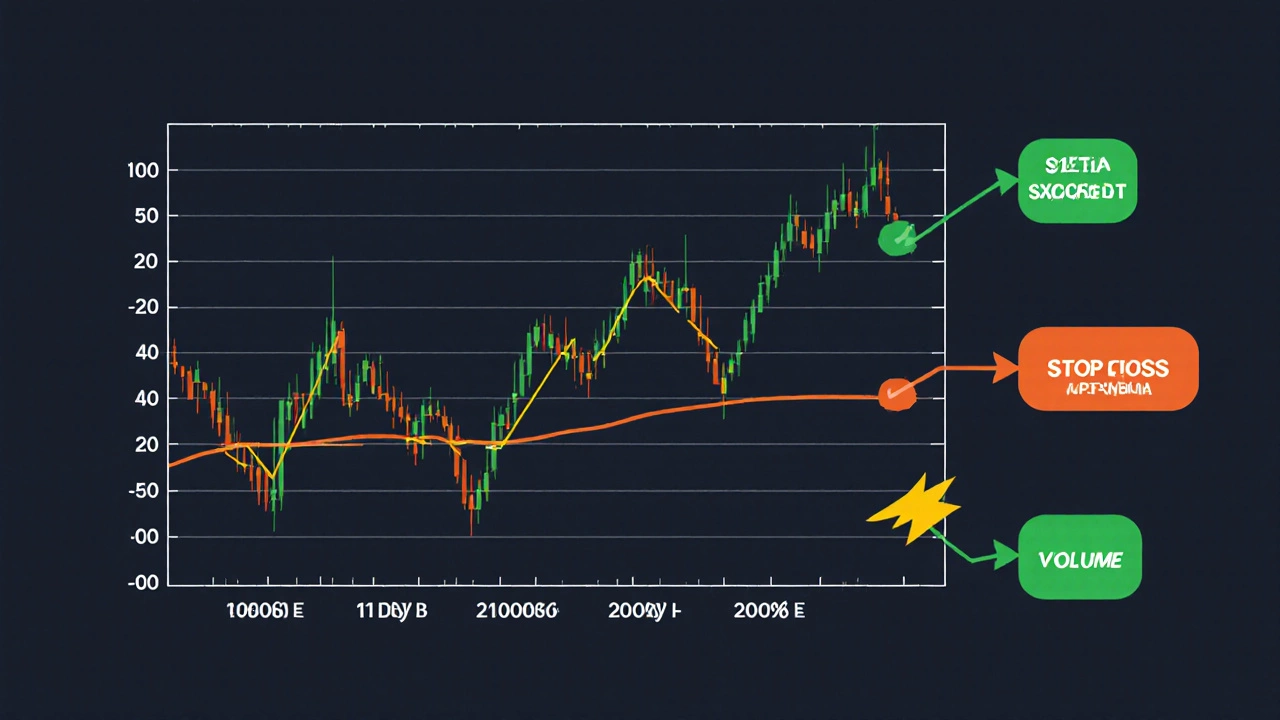
5-Rule Position Sizing Calculator
Key Takeaways
- The 5 Rule mixes trend analysis, support‑resistance zones, moving averages, risk control, and volume to create a simple trading checklist.
- It works on any liquid market - stocks, ETFs, or ADRs - but shines on daily charts for swing traders.
- Follow the step‑by‑step process to spot a trade, set a stop loss, and size your position before you press buy.
- Avoid common traps like chasing breakout volume or ignoring market‑wide news.
- Compare the 5 Rule with other popular frameworks (20% rule, 50/30/20 rule) to pick what fits your style.
Ever heard someone mention the "5 rule stock market" and wonder what it actually means? In plain English, the 5 Rule is a five‑step checklist that helps traders stay disciplined while hunting for price moves. It doesn’t promise a magic formula, but it does give you a repeatable process that cuts down on impulsive decisions.
5 Rule is a simple, five‑point trading framework that blends technical analysis with risk management. It was popularised by retail traders on online forums around 2018 and has since become a staple for beginners who want a clear roadmap before entering a trade.
1. Identify the Trend - Technical Analysis
The first leg of the rule asks you to ask a single question: Is the market trending up, down, or sideways? You can answer that by looking at higher‑timeframe charts (daily or weekly) and checking whether price is making higher highs and higher lows (uptrend) or the opposite (downtrend). Simple tools like a 50‑day moving average or a trendline work fine.
2. Spot Support and Resistance - Support and Resistance
Once you know the direction, locate the nearest price level where the market has bounced before (support) or struggled to break through (resistance). These zones act like invisible walls; price often respects them before reversing. Mark them on your chart - they become the anchors for the next steps.
3. Use Moving Averages - Moving Average
Moving averages smooth out daily noise and give you a visual cue for trend strength. The 20‑day simple moving average (SMA) works well for short‑term swings, while the 200‑day SMA is a long‑term guardrail. A classic signal is when the short‑term average crosses above the long‑term average (golden cross) in an uptrend, or crosses below (death cross) in a downtrend.

4. Apply Risk Management - Risk Management
Before you click "buy," decide how much of your capital you are willing to lose if the trade goes against you. Most seasoned traders risk 1-2 % of their account per trade. This risk amount translates into a stop‑loss distance - the price point where you’ll exit automatically.
5. Confirm with Volume - Stop Loss
Volume validates whether a price move has real buying (or selling) pressure behind it. A breakout above resistance with a volume spike is more trustworthy than a quiet drift. Conversely, a sudden surge in volume on a downtrend may signal a looming reversal, prompting you to tighten your stop loss.
Step‑by‑Step: How to Apply the 5 Rule in Real Time
- Open a daily chart of the stock you’re watching. Apply a 50‑day SMA.
- Determine the trend: if price is above the SMA and making higher highs, you’re in an uptrend.
- Identify the nearest support level. Draw a horizontal line at that price.
- Check the 20‑day SMA. If it’s crossing above the 50‑day SMA, note the crossover date.
- Calculate your position size: (Account Capital × Risk %) ÷ (Entry Price - Support Level) = Shares to buy.
- Set a stop loss just below the support zone, adding a small buffer (e.g., 0.5 %).
- Watch the volume bar: if the next day’s volume exceeds the 20‑day average by at least 30 %, proceed with the trade.
- Enter the trade at market or with a limit order near the current price, then monitor for any news that could invalidate the trend.
Common Pitfalls and How to Dodge Them
Chasing the breakout. New traders often jump in after the price spikes, thinking they’re late to the party. The 5 Rule forces you to wait for the next candle and confirm volume, which weeds out false breakouts.
Ignoring broader market sentiment. Even a perfect 5‑step setup can flop if the S&P 500 is in a sharp correction. Always glance at a market‑wide index before finalising a trade.
Setting a stop loss too tight. A stop that sits right at the support line may get hit by normal price whipsaw, turning a good trade into a loss. Add a modest buffer or use a trailing stop once the trade moves in your favour.
Over‑leveraging. Risk management is the fourth pillar for a reason - using more than 2 % per trade quickly erodes capital during a losing streak.
How the 5 Rule Stacks Up Against Other Stock Rules
| Framework | Core Focus | Typical Timeframe | Risk Guideline | Complexity |
|---|---|---|---|---|
| 5 Rule | Trend + support/resistance + volume | Daily / Swing | 1‑2 % per trade | Medium |
| 20 % Rule (Portfolio) | Overall allocation limit | Long‑term | Max 20 % in any single asset | Low |
| 50/30/20 Rule (Budget) | Income budgeting, not trading | Monthly | N/A | Low |
| Moving‑Average Crossover | Pure technical signals | Intraday / Daily | Varies | Low‑Medium |
If you’re after a quick budgeting method, the 50/30/20 rule is better. If you need a portfolio‑level safety net, the 20 % rule makes sense. For active swing trading, the 5 Rule hits the sweet spot by blending price action with risk control.
Mini FAQ
Frequently Asked Questions
Is the 5 Rule only for stocks?
No. The same checklist works on ETFs, ADRs, and even crypto tokens as long as the asset has enough daily volume for reliable support‑resistance levels.
Do I need expensive software to apply the 5 Rule?
Most free charting platforms - TradingView’s basic plan, Yahoo Finance, or broker‑provided tools - let you plot moving averages, draw lines, and view volume. That’s all you need.
How often should I revisit my stop loss?
If the price moves in your favour by at least one‑half of your initial risk distance, tighten the stop to break‑even or a small profit. This protects you from sudden reversals.
Can the 5 Rule be automated?
Yes. Many retail bots on platforms like MetaTrader or Interactive Brokers can encode the five conditions and generate alerts, but keep a human eye on news events that the bot can’t interpret.
What markets are too volatile for the 5 Rule?
Micro‑cap stocks with daily volume under 100k shares often produce erratic price spikes that break support levels without warning. Stick to mid‑cap or large‑cap equities for reliable signals.
Next Steps
- Pick a liquid stock you already follow - maybe a tech giant or a consumer staple.
- Open a free chart on TradingView, add the 20‑day and 50‑day SMAs, and draw your first support line.
- Run through the 5‑step checklist on yesterday’s price action. If all five checks line up, place a small test trade using 1 % risk.
- Log the trade in a simple spreadsheet: entry, stop, target, outcome, and what you learned.
- Repeat daily, refine your zone drawing, and gradually increase position size as your confidence grows.
Remember, no rule guarantees profits. The 5 Rule’s real power lies in its consistency - it forces you to look at the same five things every time you consider a trade. Consistency breeds discipline, and discipline is the biggest edge you can have in the stock market.





Write a comment